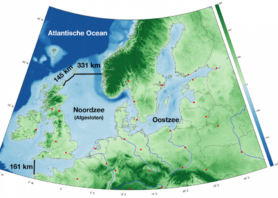Solutions to Oceanic Problems
Sacrifice the North Sea to prevent us from drowning?
The beach, the ideal place for a day away. Blowing out in the winter months or a fresh dip in the summer. But for how long can we do that? Global warming is causing sea levels to rise. If we do nothing, a quarter of the Netherlands will be flooded and our coastline will disappear. As a cry for help, oceanographer Sjoerd Groeskamp (working at the Royal Netherlands Institute for Sea Research) came out early this year with a bizarre plan. A 637 km long dam in the North Sea that protects 25 million Europeans from the water! What are the chances of this dam getting there?

In this picture you can see where Sjoerd Groeskamp would have the dam in mind. The dam is split into three sections that together are 637 km. © Sjoerd Groeskamp/NIOZ
Sea levels are rising faster and faster. During the 20th century, sea levels rose by about 15 centimeters. Today, this increase is more than twice as fast. This is in the latest climate change report, which has included more than 100 scientists from more than 30 countries. How quickly sea levels will rise in the next century is difficult to determine, according to Sjoerd. This depends on how quickly the temperature on Earth rises and how fast the ice sheets melt. We do know that, in the worst case scenario, sea levels may have risen by one to three metres by 2100. This rise increases the risk of flooding. For our low-lying country, this is a big problem. A large part is below sea level. And that’s also the part where most people live.
To protect us, and the rest of Europe, from the threat of rising sea levels, Sjoerd Groeskamp launched the idea of a dam enclosing northern Europe. The dam would be 637 km long and run from France to England and from England to Norway. Even if it sounds like a foolish plan, it is still feasible according to Groeskamp. It’s something we’ve done before in the Netherlands on a small scale. Think of the Afsluitdijk, but also of the Delta works in Zeeland. So it’s a typical idea of a Dutchman. However, there are still some technical challenges according to Sjoerd. One of them is the depth of the North Sea off the coast of Norway. It’s 1,000 feet deep there. This means that the dam would be as high as the Eiffel Tower, but mostly underwater of course. Furthermore, a lot of clay and sand will be needed to build the dam. Normally, we use 51 billion kilos of sand a year worldwide. Just as much sand will be needed to build this one dam. And all while sand is becoming increasingly scarce!
In addition to the technical bumps surrounding the construction of the dam, the 637km long dam will also have major consequences for nature and the economy. During the century, the dam will turn the North Sea into a freshwater lake. This is due to all the fresh water flowing into the sea from the Rijn, the Maas and the Waal. Think about what will happen to all the animals and plants that live there now. Shrimp, crabs and seaweed cannot survive in fresh water. We will also earn less from North Sea fishing, because most fish will not survive. And what happens to shipping? It’s going to be hard to sail with a dam on the route.
Partly because of the enormous consequences for nature and the economy, Sjoerd Groeskamp hopes that his plan never has to be implemented. “It’s about the dam being seen as a warning,” he says. “Often people are inundated with numbers when it comes to climate change. This dam is one of the few ways in which climate change can be clearly portrayed,” he explains.
In order for the dam not to be built, other human action to combat climate change will be necessary. For example, Groeskamp says that the best way to focus is on reducing the amount of CO2 in the air. With less CO2 in the air, the earth will retain less heat. As a result, the ice sheets will melt less quickly and sea levels will rise more slowly.
The Netherlands has already promised to do her best to reduce CO2 emissions. It has created a climate law which states that we must emit 49% less CO2 by 2030 compared to 1990. This is necessary to keep climate change in check. But it’s not getting too far. That’s why science is trying to develop techniques that take CO2 out of the air. In Switzerland, for example, they already do this with a vacuum cleaner! This vacuum cleaner sucks CO2 out of the air instead of dust. The CO2 is caught in a filter. This filter has been treated with a chemical that keeps CO2 attached to it. When enough CO2 is collected, it is stored and sold. For example, to soft drink producers who can use the gas to make lemonades fizz. One vacuum cleaner can extract 50 tons of CO2 from the air per year. This sounds like a lot! But if you compare it to how much CO2 the world emits every year, 40 billion tons, we still have a long way to go.
Groeskamp hopes that his plans for the dam will really give people the incentive needed to do something serious about climate change. He cannot imagine that the North Sea should be forced to change in the North Lake. According to him, the best solution remains to reduce the CO2 concentration in the air. And that’s good news, because that means that beach visits will still be in it for the foreseeable future!
Sources:
- https://www.nioz.nl/en/news/een-dam-dwars-door-de-noordzee-waarschuwscenario-voor-klimaatverandering
- https://journals-ametsoc-org.proxy.library.uu.nl/bams/article/101/7/E1174/345599/NEED-The-Northern-European-Enclosure-Dam-for-if
- https://nos.nl/artikel/2303262-nieuw-rapport-van-vn-klimaatpanel-zeespiegel-stijgt-steeds-sneller.html
- https://nos.nl/artikel/2251053-deltacommisaris-waarschuwt-voor-snellere-zeespiegelstijging.html
- https://www.vrt.be/vrtnws/nl/2019/03/06/co2-uit-de-lucht-halen-zo-doen-ze-het-in-zwitserland/
- Interview with Sjoerd Groeskamp

